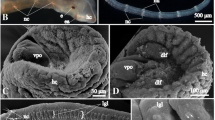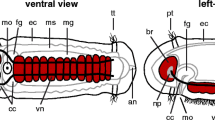Abstract
The neuropeptide FMRFamide (Phe–Met–Arg–Phe–NH2) is part of a large and diverse family of peptidergic neurotransmitters present throughout the animal kingdom. To date, no such neuropeptides have been demonstrated in gastrotrichs despite their presence in closely related invertebrates such as nematodes. Here, the FMRFamidergic nervous system of three marine gastrotrichs is investigated with immunofluorescence, CLSM, and 3D computer imaging to gain insight into structure of the cerebral ganglion and test various phylogenetic hypotheses on its organization. Results reveal that FMRFamide-like immunoreactivity (IR) is present throughout the nervous systems of three species: Neodasys cirritus (Chaetonotida), Xenodasys riedli and Turbanella cf. hyalina (Macrodasyida). Both macrodasyidans possess FMRFamide-like IR in the central, peripheral- and stomatogastric-nervous systems, while FMRFamide-like IR is restricted to the CNS in N. cirritus. In all three species, the cerebral ganglion is dumbbell-shaped and bordered bilaterally by cerebral perikarya: numerous perikarya are present in X. riedli and N. cirritus, while few perikarya are present in T. cf. hyalina. Cerebral perikarya flank the nerve ring neuropil, which contains IR fibers in the supra- and subpharyngeal commissures of both macrodasyidans, but in N. cirritus, only contains IR fibers in the suprapharyngeal commissure. Together, these results confirm the peripharyngeal nature of the gastrotrich cerebral ganglion, but are equivocal on hypotheses of its tripartite structure. Still, the neural organization of gastrotrichs, in particular, the architecture of the cerebral ganglion, is expected to hold valuable information for future assessments of gastrotrich phylogeny, and may yet provide key insights into the evolution of this enigmatic taxon.













Similar content being viewed by others
References
Bullock TH, Horridge GA (1965) Structure and function in the nervous system of invertebrates, vols I, II. WH Freeman, San Francisco
Burry RW (2000) Specificity controls for immunocytochemical methods. J Histochem Cytochem 48:163–165
Fuchs J, Bright M, Funch P, Wanninger A (2006) Immunocytochemistry of the neuromuscular systems of Loxosomella vivipara and L. parguerensis (Entoprocta: Loxosomatidae). J Morphol 267:866–883
Gagné GD (1980) Ultrastructure of the sensory palps of Tetranchyroderma papii (Gastrotricha, Macrodasyida). Zoomorphologie 95:115–125
Garey J (2001) Ecdysozoa: the relationship between Cycloneuralia and Panarthropoda. Zool Anz 240:321–330
Grimmelikhuijzen CJP (1983) FMRFamide immunoreactivity is generally occurring in the nervous systems of coelenterates. Histochem Cell Biol 78:361–381
Harszch S (2002) Neurobiologie und Evolutionsforschung: ‘Neurophylogenie” und die Stammesgeschichte der Euarthropoda. Neuroforum 4:267–273
Harszch S (2006) Neurophylogeny: architecture of the nervous system and a fresh view on arthropod phylogeny. Integr Comp Biol 46:162–194
Harzsch S, Waloszek D (2000) Serotonin-immunoreactive neurons in the ventral nerve cord of Crustacea: a character to study aspects of arthropod phylogeny. Arthropod Struct Dev 29:307–322
Hochberg R, Litvaitis MK (2001) The musculature of Dactylopodola baltica and other macrodasyidan gastrotrichs in a functional and phylogenetic perspective. Zool Scr 30:325–336
Hochberg R, Litvaitis MK (2003) Ultrastructural and immunocytochemical observations of the nervous systems of three macrodasyidan gastrotrichs. Acta Zool 84:171–178
Joffe BI, Kotikova EA (1987) Catecholamines in the nervous system of the gastrotrich Turbanella sp. Dokl Akad Nauk SSSR 296:1509–1511
Joffe BI, Wikgren M (1995) Immunocytochemical distribution of 5-HT (serotonin) in the nervous system of the gastrotrich Turbanella cornuta. Acta Zool 76:7–9
Krajniak KG (2005) Annelid endocrine disruptors and a survey of invertebrate FMRFamide-related peptides. Integr Comp Biol 45:88–96
Lehman HK, Price DA (1987) Localization of FMRFamide-like peptides in the snail Helix aspersa. J Exp Biol 131:37–53
Liesenjohann T, Neuhaus B, Schmidt-Rhaesa A (2006) Head sensory organs of Dactylopodola baltica (Macrodasyida, Gastrotricha): a combination of transmission electron microscopical and immuncytochemical techniques. J Morphol 267:897–908
Müller MCM, Sterrer W (2004) Musculature and nervous system of Gnathostomula peregrina (Gnathostomulida) shown by phalloidin labeling, immunohistochemistry, and CLSM, and their phylogenetic significance. Zoomorphology 123:169–177
Nichols R, McCormick JB, Lim IA (1999) Structure, function, and expression of Drosophila melanogaster FMRFamide-related peptides. Ann NY Acad Sci 897:264–72
Nielsen C (1995) Animal evolution. Oxford University Press, Oxford
Orrhage L, Müller MCM (2005) Morphology of the nervous system of Polychaeta (Annelida). Hydrobiologia 535/536:79–111
Price DA, Greenberg MJ (1977) Structure of a molluscan cardioexcitatory neuropeptide. Science 197:670–671
Paul DH (2003) Neurobiology of the Anomura: Paguroidea, Galtheiodea and Hippoidea. Mem Mus Vic 60:3–11
Rieger RM, Ruppert EE, Rieger GE, Schoepfer-Sterrer C (1974) On the fine structure of gastrotrichs, with a description of Chordodasys antennatus sp. n. Zool Scr 3:219–237
Rogers CM, Franks CJ, Walker RJ, Burke JF, Holden-Dye L (2001) Regulation of the pharynx of Caenorhabditis elegans by 5-HT, octopamine, and FMRFamide-like neuropeptides. J Neurobiol 49:235–244
Ruppert EE (1982) Comparative ultrastructure of the gastrotrich pharynx and the evolution of myopeithelial foreguts in Aschelminthes. Zoomorphology 99:181–220
Ruppert EE (1991) Gastrotricha. In: F Harrison, E.E. Ruppert (Eds) Microscopic anatomy of invertebrates, vol 4, Aschelminthes. Wiley, Washington, pp 41–109
Schinkmann K, Li C (1992) Localization of FMRFamide-like peptides in Caenorhabditis elegans. J Comp Neurol 316:251–260
Schmidt-Rhaesa A (1996) The nervous system of Nectonema munidae and Gordius aquaticus, with implications for the ground pattern of the Nematomorpha. Zoomorphology 116:133–142
Shaw C, Maule AG, Halton DW (1996) Platyhelminth FMRFamide-related peptides. Int J Parasitol 26:335–45
Teuchert G (1976) Sinneseinrichtigungen bei Turbanella cornuta Remane (Gastrotricha). Zoomorphologie 83:193–207
Teuchert G (1977) The ultrastructure of the marine gastrotrich Turbanella cornuta Remane (Macrodasyoidea) and its functional and phylogenetic importance. Zoomorphologie 88:189–246
Todaro MA, Guidi L, Leasi F, Tongiorgi P (2006) Morphology of Xenodasys (Gastrotricha): the first species from the Mediterranean Sea and the establishment of Chordodasiopsis gen. nov. and Xenodasyidae fam. nov. J Mar Biol Assoc UK 86:1005–1015
Travis PB (1983) Ultrastructural study of body wall organization and Y-cell composition in the Gastrotricha. Z Zool Syst Evol 21:52–68
Wanninger A (2005) Immunocytochemistry of the musculature and the nervous system of the chordoid larva of Symbion pandora (Cycliophora). J Morphol 255:237–243
Wiedermann A (1995) Zur Ultrastruktur des Nervensystems bei Cephalodasys maximus (Macrodasyida, Gastrotricha). Microfauna Mar 10:173–233
Acknowledgments
The author is grateful for the comments by two anonymous reviewers that improved this manuscript. The author is also grateful to the staff at the Smithsonian Marine Station in Fort Pierce, Florida for their assistance in collection and the use of their facilities. This research received financial support from the University of Massachusetts Lowell and from the Sumner Gerard Foundation at the Smithsonian Marine Station at Fort Pierce, Florida. This is Smithsonian Marine Station at Fort Pierce contribution 706.
Author information
Authors and Affiliations
Corresponding author
Rights and permissions
About this article
Cite this article
Hochberg, R. Comparative immunohistochemistry of the cerebral ganglion in Gastrotricha: an analysis of FMRFamide-like immunoreactivity in Neodasys cirritus (Chaetonotida), Xenodasys riedli and Turbanella cf. hyalina (Macrodasyida). Zoomorphology 126, 245–264 (2007). https://doi.org/10.1007/s00435-007-0044-2
Received:
Revised:
Accepted:
Published:
Issue Date:
DOI: https://doi.org/10.1007/s00435-007-0044-2




